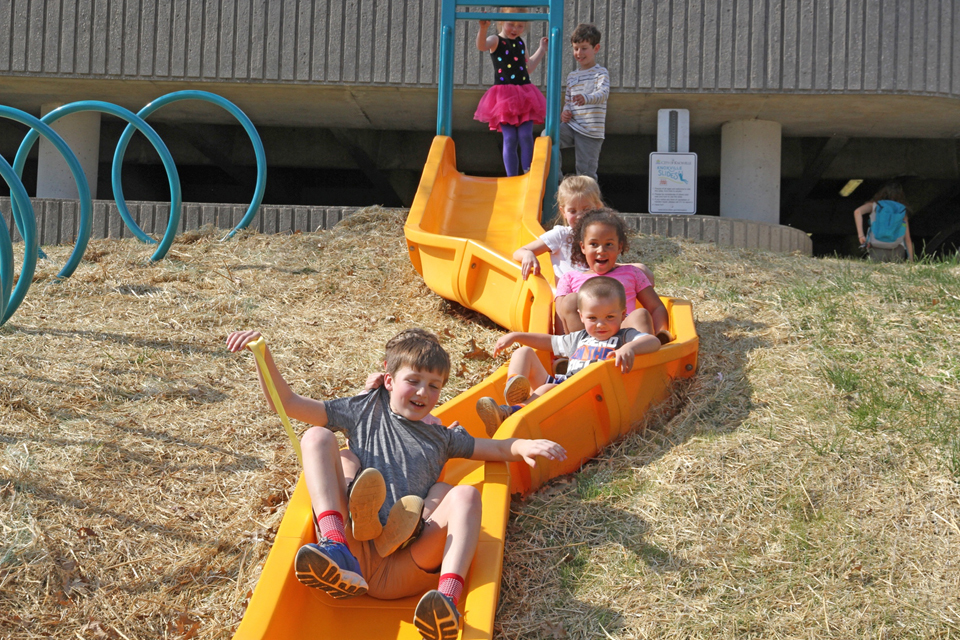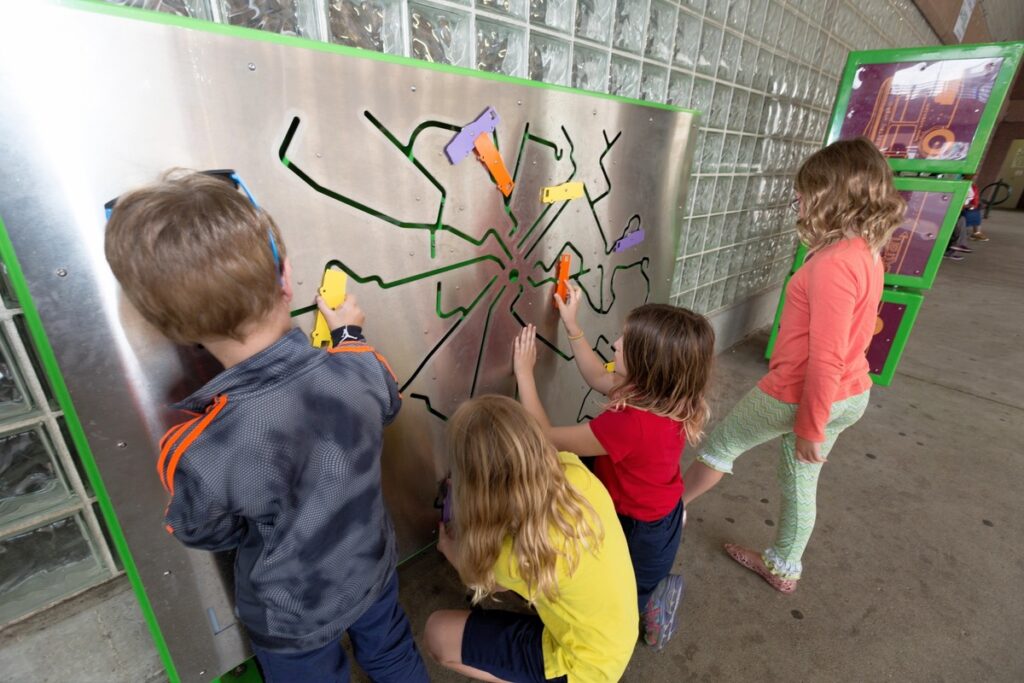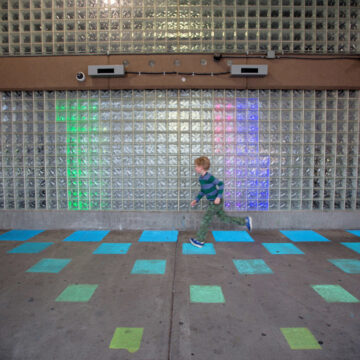For families and caregivers, taking public transportation with kids can be frustrating and unpredictable. Beyond the potential hassles and inefficiencies of taking transit, the physical spaces where families wait for and access transit—bus stops, rail and subway platforms, kiss-and-rides, and transit centers or terminals—only exacerbate the frustrations. These overlooked public spaces are full of blank walls and hard benches, are often unprotected from the elements, are sometimes unsafe and certainly offer little for kids to do before the next bus or train arrives. However, these same transit spaces offer a variety of untapped opportunities for play.
From bus shelters and the areas around bus stops, to subway platform walls and the waiting areas of transit centers, such spaces can be transformed into dynamic and rewarding places to play. If taking public transportation becomes an opportunity for play along the way, the often-onerous process of getting from place to place, and waiting once you get there, can become a joyful and meaningful experience for both kids and the adults in their lives.

Design principles
Infusing play into the transit experience requires seizing the many opportunities presented by transit facilities and infrastructure, as well as the spaces around and between them. Given the many different modes of transit, opportunities for Play Everywhere can be quite varied, and can take place around stops and platforms, within stations and terminals and even on board transit vehicles.
Bus stops (streetcar or light rail stops, where applicable)
From the stops themselves to the structures that house them and the spaces that surround them, bus stops (as well as streetcar and light rail stops along the street) can host a range of playful activities and installations. The possibilities include, but are not limited to:
- Retrofitting existing transit shelters to accommodate play opportunities that pass the time. For example, libraries of kids’ books, art and murals embedded in the walls and structure, playful lighting and benches, games and art on the pavement or perhaps playful elements incorporated into the real-time transit information and digital ad displays now appearing at some bus stops.
- Partnering with transit agencies (or other entities responsible for bus shelter design and construction) to custom-design new shelters at bus stops where no shelter currently exists. The new shelters can incorporate playful designs or integrated play elements (a win-win solution for both riders and transit agencies).
- Incorporating play installations into adjacent spaces around the stop, including expanses of sidewalk and adjacent open spaces such as grassy areas or hillsides (see also Streets and Sidewalks).
- Exploring partnerships with the entities responsible for bus shelter advertising. In some cities, these same entities are responsible for the shelters themselves as part of advertising contracts. Cities could repurpose the space normally reserved for ads in creative ways that inspire play. For example, incorporating games or puzzles into the shelter to pass the time while waiting for the bus. Not only are advertising agencies sometimes required to post public-service ads, but doing so offers the potential to replicate the playful intervention at other bus stops in the system.

Stations, terminals, and transit centers
These facilities range from small facilities with a single transit platform, to larger and more complex transit hubs with a range of internal spaces, functions and amenities. Depending on the facility, opportunities for Play Everywhere include:
- Making the waiting areas within stations and transit centers places for play.
- Painting playful murals on the walls, floors, platforms and corridors of transit stations and terminals.
- Incorporating playful sounds or music in stations that use audio systems in between announcements or in select locations such as platforms, corridors, staircases or escalators. (Some transit systems, in cities such as Tokyo and New York City , have experimented with recorded bird sounds as ways help the visually impaired navigate stations and scare away pigeons. Why not use animal sounds to let kids’ imaginations run wild?)
- Integrating play installations into the parking garages associated with many stations and transit.
- Incorporating playful wayfinding elements, such as signs, paint and art, to highlight and animate the way to the transit stops, platforms and station exits.
On board
While there are ample opportunities to fill downtime before and after riding transit, there are also ways for transit vehicles themselves to provide “play on the way,” such as:
- Replacing some of the advertising or public service announcements on transit vehicles with kid-oriented art, games or puzzles to pass the time during the ride. Many transit agencies already incorporate adult-oriented art, quotes and poems into such spaces. Why not play, too?
- Encouraging transit agencies to decorate the exteriors of transit vehicles or rail cars with playful art, to enliven a family’s wait for its ride home.
General considerations
- Analyze ridership patterns and demographics to maximize the impact of a play installation. Target the stops, stations and routes frequented by kids and families. For outdoor stops and stations, also consider patterns of pedestrian activity or land uses in the surrounding areas to identify the best places to attract additional families en route to other destinations and activities (see also “Streets and Sidewalks”).
- Understand the ownership of the spaces around transit. Are they public space, private property or owned by a transit agency? Are there any restrictions on the use of these spaces? Recognize that some transit agencies have system-wide requirements that govern the physical and visual characteristics of transit facilities, but talk to them anyway about opportunities for Play Everywhere installations.
- Identify particular routes and stops with excess spaces—along the sidewalk, on platforms or elsewhere within a station—that could be reallocated or reclaimed for play.
- Understand the multiple entities responsible for transit services and facilities. Identify the best partners, including transit agencies, city transportation or public works departments and the private contractors who may operate transit vehicles or manage transit advertising.
- Explore opportunities to leverage new multimedia technology that has begun to emerge at transit stops and stations and on transit vehicles themselves, such as real time travel information and rotating video display ads.
